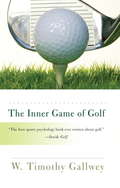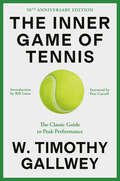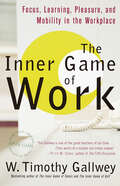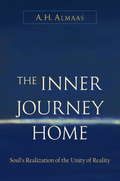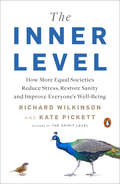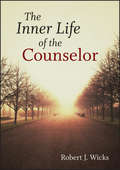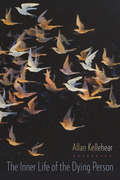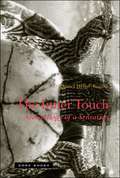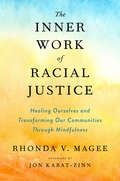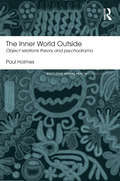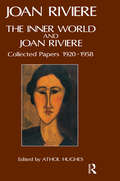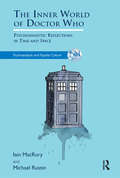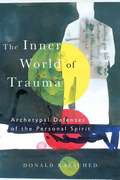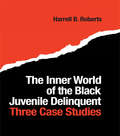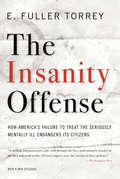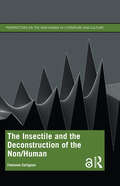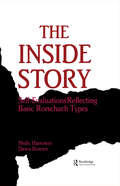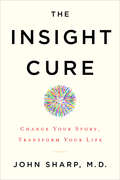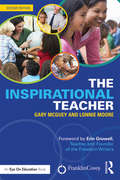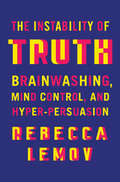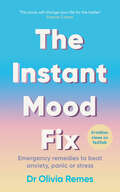- Table View
- List View
The Inner Game Of Golf
by W. Timothy GallweyW. Timothy Gallwey's bestselling Inner Game books--with over one million copies sold--have revolutionized the way we think about sports. And now, after twenty years of applying his Inner Game methods to the royal and ancient sport of golf, Gallwey brings us this completely revised edition of his classic The Inner Game of Golf, nearly half of which is new material, published here for the first time. Even the masters of the game, from the venerable Jack Nicklaus to the wunderkind Tiger Woods, must battle their mental demons to excel in the crucible of competition. How do they maintain concentration under pressure? How do they avoid the mental and physical tensions that can sabotage any shot, from the simplest putt to a demanding drive? And how do they contend with the nagging inner voice that says, "You haven't been playing your best today. How will you keep from messing up on this shot?" Here, Gallwey provides specific ways for you to improve the concentration and confidence that keep your insecurities from hijacking your best instincts, your score, and your enjoyment of the game. In addition to the specifics of Inner chipping, Inner swinging, and Inner putting, Gallwey explains why the art of "relaxed concentration" is the fundamental skill for improving every aspect of your game. It may seem like common sense nowadays to say that mental approaches are as crucial as physical skills in a good game of golf. But Gallwey was among the first to say it, and he is a pioneer of the modern sports psychology movement. In The Inner Game of Golf, now comprehensively updated, you will find the kind of perceptive and articulate instruction that not only will improve your swing, but, perhaps even more important, will reacquaint you with the pure pleasure of the game.
The Inner Game of Tennis: The Classic Guide to the Mental Side of Peak Performance
by W. Timothy GallweyThe timeless guide to achieving the state of &“relaxed concentration&” that&’s not only the key to peak performance in tennis but the secret to success in life itself—part of the bestselling Inner Game series, with more than one million copies sold!&“Groundbreaking . . . the best guide to getting out of your own way . . . Its profound advice applies to many other parts of life.&”—Bill Gates, GatesNotes (&“Five of My All-Time Favorite Books&”) This phenomenally successful guide to mastering the game from the inside out has become a touchstone for hundreds of thousands of people. Billie Jean King has called the book her tennis bible; Al Gore has used it to focus his campaign staff; and Itzhak Perlman has recommended it to young violinists. Based on W. Timothy Gallwey&’s profound realization that the key to success doesn&’t lie in holding the racket just right, or positioning the feet perfectly, but rather in keeping the mind uncluttered, this transformative book gives you the tools to unlock the potential that you&’ve possessed all along. &“The Inner Game&” is the one played within the mind of the player, against the hurdles of self-doubt, nervousness, and lapses in concentration. Gallwey shows us how to overcome these obstacles by trusting the intuitive wisdom of our bodies and achieving a state of &“relaxed concentration.&” With chapters devoted to trusting the self and changing habits, it is no surprise then, that Gallwey&’s method has had an impact far beyond the confines of the tennis court. Whether you want to play music, write a novel, get ahead at work, or simply unwind after a stressful day, Gallwey shows you how to tap into your utmost potential. No matter your goals, The Inner Game of Tennis gives you the definitive framework for long-term success.
The Inner Game of Work: Focus, Learning, Pleasure, and Mobility in the Workplace
by W. Timothy GallweyDo you think it's possible to truly enjoy your job? No matter what it is or where you are? Timothy Gallwey does, and in this groundbreaking book he tells you how to overcome the inner obstacles that sabotage your efforts to be your best on the job. Timothy Gallwey burst upon the scene twenty years ago with his revolutionary approach to excellence in sports. His bestselling books The Inner Game of Tennis and The Inner Game of Golf, with over one million copies in print, changed the way we think about learning and coaching. But the Inner Game that Gallwey discovered on the tennis court is about more than learning a better backhand; it is about learning how to learn, a critical skill that, in this case, separates the productive, satisfied employee from the rest of the pack. For the past twenty years Gallwey has taken his Inner Game expertise to many of America's top companies, including AT&T, Coca-Cola, Apple, and IBM, to teach their managers and employees how to gain better access to their own internal resources. What inner obstacles is Gallwey talking about? Fear of failure, resistance to change, procrastination, stagnation, doubt, and boredom, to name a few. Gallwey shows you how to tap into your natural potential for learning, performance, and enjoyment so that any job, no matter how long you've been doing it or how little you think there is to learn about it, can become an opportunity to sharpen skills, increase pleasure, and heighten awareness. And if your work environment has been turned on its ear by Internet technology, reorganization, and rapidly accelerating change, this book offers a way to steer a confident course while navigating your way toward personal and professional goals. The Inner Game of Workteaches you the difference between a rote performance and a rewarding one. It teaches you how to stop working in the conformity mode and start working in the mobility mode. It shows how having a great coach can make as much difference in the boardroom as on the basketball court-- and Gallwey teaches you how to find that coach and, equally important, how to become one. The Inner Game of Work challenges you to reexamine your fundamental motivations for going to work in the morning and your definitions of work once you're there. It will ask you to reassess the way you make changes and teach you to look at work in a radically new way. "Ever sinceThe Inner Game of Tennis, I've been fascinated and have personally benefitted by the incredibly empowering insights flowing out of Gallwey's self-one/self-two analysis. This latest book applies this liberating analogy to work inspiring all of us to relax and trust our true self. " --Stephen R. Covey, author of7 Habits of Highly Effective People
The Inner Journey Home: The Soul's Realization of the Unity of Reality
by A. H. AlmaasWhat is the soul, and how do we come to know it? What is its journey in life, and what stages and obstacles are encountered along the way? These questions are explored here in detail according to the Diamond Approach, a spiritual path that combines systematic inquiry into personal experience, the practice of traditional spiritual methods, and the application of modern psychological research. The Inner Journey Home is the centerpiece of the Diamond Approach literature, providing a complete overview of the teaching with references to the author's other books for more details on certain topics.
The Inner Level: How More Equal Societies Reduce Stress, Restore Sanity and Improve Everyone's Well-Being
by Kate Pickett Richard WilkinsonA groundbreaking investigation of how inequality infects our minds and gets under our skinWhy are people more relaxed and at ease with each other in some countries than others? Why do we worry so much about what others think of us and often feel social life is a stressful performance? Why is mental illness three times as common in the USA as in Germany? Why is the American dream more of a reality in Denmark than the USA? What makes child well-being so much worse in some countries than others? As The Inner Level demonstrates, the answer to all these is inequality. In The Spirit Level Richard Wilkinson and Kate Pickett put inequality at the center of public debate by showing conclusively that less equal societies fare worse than more equal ones across everything from education to life expectancy. The Inner Level now explains how inequality affects us individually, altering how we think, feel and behave. It sets out the overwhelming evidence that material inequities have powerful psychological effects: when the gap between rich and poor increases, so does the tendency to define and value ourselves and others in terms of superiority and inferiority. A deep well of data and analysis is drawn upon to empirically show, for example, that low social status leads to elevated levels of stress hormones, and how rates of anxiety, depression and addictions are intimately related to the inequality which makes that status paramount. Wilkinson and Pickett describe how these responses to hierarchies evolved, and why the impacts of inequality on us are so severe. In doing so, they challenge the conception that humans are inescapably competitive and self-interested. They undermine, too, the idea that inequality is the product of "natural" differences in individual ability. This book draws together many of the most urgent problems facing societies today, but it is not just an index of our ills. It demonstrates that societies based on fundamental equalities, sharing and reciprocity generate much higher levels of well-being, and lays out the path towards them.
The Inner Life of the Counselor
by Robert J. WicksOne of the greatest gifts helping professionals can share with others is a sense of their own peace. However, retaining and renewing a sense of a healthy perspective requires not only self-care strategies, but also an awareness of basic profound, yet simple, wisdom themes. The Inner Life of the Counselor presents classic and contemporary wisdom that examines and explores each of these themes in a way that both professional and non-professional helpers will find revealing and meaningful in understanding their own journey. Informed by the author's over thirty years of experience as a therapist, mentor, and clinical supervisor of professional helpers?as well as by his expertise in resiliency and prevention of secondary stress?The Inner Life of the Counselor thoughtfully looks at those elements that encourage sustained personal growth and professional development, such as self-care, stress management, and mindfulness. Lively, practical, and marked by an elegant sense of simplicity, this nurturing book demonstrates how exploring the inner life can lead counselors to new wisdom and inner peace?not only for themselves but also for those who come to them for relief and insight. It is an invitation to pause, reflect, renew, and navigate one of contemporary society's most challenging yet rewarding professions.
The Inner Life of the Dying Person
by Allan KellehearThis unique book recounts the experience of facing one's death solely from the dying person's point of view rather than from the perspective of caregivers, survivors, or rescuers. Such unmediated access challenges assumptions about the emotional and spiritual dimensions of dying, showing readers that -- along with suffering, loss, anger, sadness, and fear -- we can also feel courage, love, hope, reminiscence, transcendence, transformation, and even happiness as we die.A work that is at once psychological, sociological, and philosophical, this book brings together testimonies of those dying from terminal illness, old age, sudden injury or trauma, acts of war, and the consequences of natural disasters and terrorism. It also includes statements from individuals who are on death row, in death camps, or planning suicide. Each form of dying addressed highlights an important set of emotions and narratives that often eclipses stereotypical renderings of dying and reflects the numerous contexts in which this journey can occur outside of hospitals, nursing homes, and hospices. Chapters focus on common emotional themes linked to dying, expanding and challenging them through first-person accounts and analyses of relevant academic and clinical literature in psycho-oncology, palliative care, gerontology, military history, anthropology, sociology, cultural and religious studies, poetry, and fiction. The result is an all-encompassing investigation into an experience that will eventually include us all and is more surprising and profound than anyone can imagine.
The Inner Life of the Dying Person
by Allan KellehearThis unique book recounts the experience of facing one's death solely from the dying person's point of view rather than from the perspective of caregivers, survivors, or rescuers. Such unmediated access challenges assumptions about the emotional and spiritual dimensions of dying, showing readers that -- along with suffering, loss, anger, sadness, and fear -- we can also feel courage, love, hope, reminiscence, transcendence, transformation, and even happiness as we die.A work that is at once psychological, sociological, and philosophical, this book brings together testimonies of those dying from terminal illness, old age, sudden injury or trauma, acts of war, and the consequences of natural disasters and terrorism. It also includes statements from individuals who are on death row, in death camps, or planning suicide. Each form of dying addressed highlights an important set of emotions and narratives that often eclipses stereotypical renderings of dying and reflects the numerous contexts in which this journey can occur outside of hospitals, nursing homes, and hospices. Chapters focus on common emotional themes linked to dying, expanding and challenging them through first-person accounts and analyses of relevant academic and clinical literature in psycho-oncology, palliative care, gerontology, military history, anthropology, sociology, cultural and religious studies, poetry, and fiction. The result is an all-encompassing investigation into an experience that will eventually include us all and is more surprising and profound than anyone can imagine.
The Inner Life of the Dying Person (End-of-Life Care: A Series)
by Allan KellehearThis unique book recounts the experience of facing one's death solely from the dying person's point of view rather than from the perspective of caregivers, survivors, or rescuers. Such unmediated access challenges assumptions about the emotional and spiritual dimensions of dying, showing readers that—along with suffering, loss, anger, sadness, and fear—we can also feel courage, love, hope, reminiscence, transcendence, transformation, and even happiness as we die. A work that is at once psychological, sociological, and philosophical, this book brings together testimonies of those dying from terminal illness, old age, sudden injury or trauma, acts of war, and the consequences of natural disasters and terrorism. It also includes statements from individuals who are on death row, in death camps, or planning suicide. Each form of dying addressed highlights an important set of emotions and narratives that often eclipses stereotypical renderings of dying and reflects the numerous contexts in which this journey can occur outside of hospitals, nursing homes, and hospices. Chapters focus on common emotional themes linked to dying, expanding and challenging them through first-person accounts and analyses of relevant academic and clinical literature in psycho-oncology, palliative care, gerontology, military history, anthropology, sociology, cultural and religious studies, poetry, and fiction. The result is an all-encompassing investigation into an experience that will eventually include us all and is more surprising and profound than anyone can imagine.
The Inner Touch: Archaeology Of A Sensation
by Daniel Heller-RoazenThe Inner Touch presents the archaeology of a single sense: the sense of being sentient. Aristotle was perhaps the first to define this faculty when in his treatise On the Soul he identified a sensory power, irreducible to the five senses, by which animals perceive that they are perceiving: the simple "sense," as he wrote, "that we are seeing and hearing." After him, thinkers returned, time and again, to define and redefine this curious sensation. The classical Greek and Roman philosophers as well as the medieval Arabic, Hebrew, and Latin thinkers who followed them all investigated a power they called "the common sense," which one ancient author likened to "a kind of inner touch, by which we are able to grasp ourselves." Their many findings were not lost with the waning of the Middle Ages. From Montaigne and Francis Bacon to Locke, Leibniz, and Rousseau, from nineteenth-century psychiatry and neurology to Proust and Walter Benjamin, the writers and thinkers of the modern period have turned knowingly and unknowing to the terms of older traditions in exploring the perception that every sensitive being possesses of its life. The Inner Touch reconstructs and reconsiders the history of this perception. In twenty-five concise chapters that move freely among ancient, medieval, and modern cultures, Daniel Heller-Roazen investigates a set of exemplary phenomena that have played central roles in philosophical, literary, psychological, and medical accounts of the nature of animal existence. Here sensation and self-sensation, sleeping and waking, aesthetics and anesthetics, perception and apperception, animal nature and human nature, consciousness and unconsciousness, all acquire a new meaning. The Inner Touch proposes an original, elegant, and far-reaching philosophical inquiry into a problem that has never been more pressing: what it means to feel that one is alive.Winner of the Aldo and Jeanne Scaglione Prize for Comparative Literary Studies
The Inner Work of Racial Justice: Healing Ourselves and Transforming Our Communities Through Mindfulness
by Rhonda V. MageeAn essential mindfulness and compassion-based approach to confront racial injustice and work towards healing Law professor and mindfulness practitioner Rhonda Magee shows that the work of racial justice begins with ourselves. When conflict and division are everyday realities, our instincts tell us to close ranks, to find the safety of our own tribe, and to blame others. The practice of embodied mindfulness--paying attention to our thoughts, feelings, and physical sensations in an open, nonjudgmental way--increases our emotional resilience, helps us to recognize our unconscious bias, and gives us the space to become less reactive and to choose how we respond to injustice.For victims of injustice, embodied mindfulness calms our fears and helps us to exercise self-compassion. Magee shows us how to slow down and reflect on microaggressions--to hold them with some objectivity and distance--rather than bury unpleasant experiences so they have a cumulative effect over time. She helps us develop the capacity to address the fears and anxieties that would otherwise lead us to re-create patterns of separation and division.It is only by healing from injustices and dissolving our personal barriers to connection that we develop the ability to view others with compassion and to live in community with people of vastly different backgrounds and viewpoints. Incorporating mindfulness exercises, research, and Magee's hard-won insights, The Inner Work of Racial Justice offers a road map to a more peaceful world.
The Inner World Outside: Object Relations Theory and Psychodrama (Routledge Mental Health Classic Editions)
by Paul HolmesFirst published in 1993, The Inner World Outside has become a classic in its field. Paul Holmes walks the reader through the ‘inner world’ of object relationships and the corresponding ‘outside world’ shared by others in which real relationships exist. Trained as a psychotherapist in both psychoanalytical and psychodramatic methods, Paul Holmes has written a well informed, clear introduction to Object Relations Theory and its relation to psychodrama. He explores the links between the theories of J.L. Moreno, the founder of psychodrama, and Sigmund Freud, the founder of psychoanalysis, and presents a stimulating synthesis. Each chapter opens with an account of part of a psychodrama session which focus on particular aspects of psychodrama or object relations theory illuminating the concepts or techniques using the clinical material from the group to illustrate basic psychoanalytic concepts in action. Published here with a new introduction from the author that links the book’s content to concepts of attachment theory, the book weaves together the very different concepts in an inspiring and comprehensive way that will ensure the book continues to be used by mental health and arts therapies professional, whether in training or practice.
The Inner World and Joan Riviere: Collected Papers 1929 - 1958
by Joan RiviereAlthough best known as a disseminator of Freudian and Kleinian ideas, the author also contributed important and original material to the body of psychoanalytic literature. This volume presents some of this material and highlights the importance of the author's contribution.
The Inner World of Doctor Who: Psychoanalytic Reflections in Time and Space (The\psychoanalysis And Popular Culture Ser.)
by Michael Rustin Iain MacRuryAs Doctor Who approaches its fiftieth anniversary recent series have taken the show to new heights in terms of popular appeal and critical acclaim.The Doctor and his TARDIS-driven adventures, along with companions and iconic monsters, are now recognised and enjoyed globally. The time is ripe for a detailed analytic assessment of this cultural phenomenon. Focussing on the most recent television output The Inner World of Doctor Who examines why the show continues to fascinate contemporary audiences. Presenting closely-observed psychoanalytic readings of selected episodes, this book examines why these stories of time travel, monsters, and complex human relationships have been successful in providing such an emotionally rich dramatization of human experience. The Inner World of Doctor Who seeks to explore the multiple cultural and emotional dimensions of the series, moving back and forth from behind the famous sofa, where children remember hiding from scary monsters, and onto the proverbial psychoanalytic couch.
The Inner World of Trauma: Archetypal Defences of the Personal Spirit
by Donald KalschedDonald Kalsched explores the interior world of dream and fantasy images encountered in therapy with people who have suffered unbearable life experiences. He shows how, in an ironical twist of psychical life, the very images which are generated to defend the self can become malevolent and destructive, resulting in further trauma for the person. Why and how this happens are the questions the book sets out to answer. Drawing on detailed clinical material, the author gives special attention to the problems of addiction and psychosomatic disorder, as well as the broad topic of dissociation and its treatment. By focusing on the archaic and primitive defenses of the self he connects Jungian theory and practice with contemporary object relations theory and dissociation theory. At the same time, he shows how a Jungian understanding of the universal images of myth and folklore can illuminate treatment of the traumatised patient. Trauma is about the rupture of those developmental transitions that make life worth living. Donald Kalsched sees this as a spiritual problem as well as a psychological one and in The Inner World of Trauma he provides a compelling insight into how an inner self-care system tries to save the personal spirit.
The Inner World of the Black Juvenile Delinquent: Three Case Studies
by Harrell B. RobertsFirst published in 1987. Routledge is an imprint of Taylor & Francis, an informa company.
The Insanity Offense: How America's Failure to Treat the Seriously Mentally Ill Endangers Its Citizens
by E. Fuller Torrey"Vital for all working in the mental health field . . . . Fascinating reading for anyone." --Choice E. Fuller Torrey, the author of the definitive guides to schizophrenia and manic depression, chronicles a disastrous swing in the balance of civil rights that has resulted in numerous violent episodes and left a vulnerable population of mentally ill people homeless and victimized. Interweaving in-depth accounts of landmark cases in California, Wisconsin, and North Carolina with a history of legislation and changes in the mental health care system, Torrey gives shape to the magnitude of our failure and outlines what needs to be done to reverse this ongoing--and accelerating--disaster. A new epilogue on the 2011 shooting in Tucson, Arizona, brings this tragic story up to date.
The Insectile and the Deconstruction of the Non/Human (Perspectives on the Non-Human in Literature and Culture)
by Fabienne CollignonThe Insectile and the Deconstruction of the Non/Human defines, conceptualizes, and evaluates the insectile—pertaining to an entomological fascination—in relation to subject formation. The book is driven by a central dynamic between form and formlessness, further staging an investigation of the phenomenon of fascination using Lacanian psychoanalysis, suggesting that the psychodrama of subject formation plays itself out entomologically. The book’s engagement with the insectile—its enactments, cultural dreamwork, fantasy transformations—‘in-forming’ the so-called human subject undertakes a broader deconstruction of said subject and demonstrates the foundational but occluded role of the insectile in subject formation. It tracks the insectile across the archives of psychoanalysis, seventeenth century still life painting, novels from the nineteenth century to the present day, and post-1970s film. The Insectile and the Deconstruction of the Non/Human will be of interest for scholars, graduate students, and upper-level undergraduates in film studies, visual culture, popular culture, cultural and literary studies, comparative literature, and critical theory, offering the insectile as new category for theoretical thought.
The Inside Scoop on Eating Disorder Recovery: Advice from Two Therapists Who Have Been There
by Colleen Reichmann Jennifer RollinThe Inside Scoop on Eating Disorder Recovery is a fresh, smart, how-to book that helps people with eating disorders to heal their relationship with food, their bodies, and ultimately themselves. Written from the perspective of two eating disorder therapists, both of whom are recovered from their own eating disorders, the text uses humor, personal narratives, and research-proven techniques to offer specific actionable guidelines on how to reclaim one’s life from an eating disorder. The authors explain the difference between dieting and eating disorders, break down the stages of recovery, and provide tips on how to thrive in each stage. The book provides powerful myth-busting on topics that have historically not been addressed in eating disorder recovery books, such as clean eating and orthorexia, exercising in recovery, and fat positivity. Tangible exercises at the end of each chapter provide readers with advice and tips on implementing this approach to recovery in their day-to-day lives. The humorous and down-to-earth tone of the book creates an authentic and genuine feel that leaves those who struggle with chronic dieting, eating disorders, and negative body image feeling connected and heard.
The Inside Story: Self-evaluations Reflecting Basic Rorschach Types (Personality Assessment Series)
by Molly Harrower Dawn BowersThis unusual book was written to provide a glimpse into the inner "Rorschach" world of individuals -- psychology students in training -- representing the basic Rorschach subtypes. The Rorschach records of these graduate students in clinical psychology are presented along with their own interpretations and analyses of their records. In short, The Inside Story offers both a new approach to learning projective diagnostic methods such as the Rorschach and a new experience in the adventure of self-understanding.
The Inside Story: Understanding the Power of Feelings
by The Editors at HeartMathWith exercises in each chapter, the book explores our 3 brains and how they produce our emotions.
The Insight Cure: Change Your Story, Transform Your Life
by John SharpEvery person has a story, a personal narrative that informs their life, their decisions, and their way of thinking. But did you know that it also affects the wiring of your brain? <P><P>Renowned psychiatrist and professor at Harvard Medical School John Sharp, M.D., offers an eight-step process to discovering your unconscious narrative and using your new insight to eradicate the "false truth" that has been at the core of your self-sabotage. His unique approach integrates four core domains of applied psychology—control mastery theory, attachment theory, narrative therapy, and positive psychology—with his own research and professional experience to construct an insightful and soul-searching path to insight. <P><P>Dr. Sharp’s approach is simple and accessible, with the power to wield profound results. Through exercises, quizzes, thorough exploration of case studies, and clear guidance, you will be able to find your false truth, rewrite your story, and transform your life. Once you have flipped the switch of insight, nothing can hold back the light that shines from within.
The Inspirational Teacher
by Gary McGuey Lonnie MooreBecome a teacher who truly inspires students to learn and grow! This bestselling book—from Routledge and Franklin Covey, the company that brought you The 7 Habits of Highly Effective People—is filled with practical and heartfelt advice that will resonate with teachers at all stages of their careers. The book will guide you through a simple four step process to building high-trust relationships and unleashing the greatness within all students. This timely new edition includes updated references and inspirational quotes throughout, as well as chapter reflection questions to help you make the most of what you read. In addition, several of the questionnaires and reflection tools from the book are also available on our website as free eResources, so that you can easily print and use them in your own classroom. http://www.routledge.com/books/details/9781138906242.
The Instability of Truth: Brainwashing, Mind Control, and Hyper-Persuasion
by Rebecca LemovAn acclaimed historian of science uncovers the hidden history of brainwashing—and its troubling implications for today. Because brainwashing affects both the world and our observation of the world, we often don’t recognize it while it’s happening—unless we know where to look. As Rebecca Lemov writes in The Instability of Truth, “Brainwashing erases itself.” What we call brainwashing is more common than we think; it is not so much what happens to other people as what can happen to anyone. The Instability of Truth exposes the myriad ways our minds can be controlled against our will, from the brainwashing techniques used against American POWs in North Korea to the “soft” brainwashing of social media doomscrolling and behavior-shaping. In our increasingly data-driven world, anyone can fall victim to mind control. Lemov identifies invasive forms of emotional engineering that exploit trauma and addiction to coerce and persuade in everyday life. Tracing the word “brainwashing” from deep in the files of an operative of the U.S. Office of Strategic Services in the 1950s to the pioneering research of Robert Jay Lifton, to the public trials of cult leaders and the case of Patty Hearst, Lemov also studies how the idea of mind control has spread across the globe and penetrated courtrooms, secret labs, military schools, and today’s digital sites. The Instability of Truth offers lessons from mind-control episodes past and present. Truth is always subject to question in more mundane walks of life than most people believe, and Lemov equips us for the increasing challenges we face from social media, AI, and an unprecedented, global form of surveillance capitalism. The Instability of Truth develops a rigorous new understanding of both brainwashing’s paradoxes and its emotional roots, by giving voice to brainwashers, the brainwashed, and third-party observers alike.
The Instant Mood Fix: Emergency Remedies to Beat Anxiety, Panic or Stress
by Olivia Remes50 simple, science-backed solutions to cope with stress, anxiety, procrastination, and moments of crisis for more balanced mental health.When panic strikes, grab this book.University of Cambridge mental health researcher Dr. Olivia Remes has spent the past decade uncovering the secrets to reducing anxiety, stress, and panic. In this short, no-nonsense book, Dr. Olivia gives you 50 simple, science-based solutions to fight the moods that hold us all back. Targeting everything from overwhelm to indecision and anxiety to lack of motivation, these unexpected tips and tricks will help you relieve the pressure in the short term and experience long-term post-traumatic growth.The essential book for when you're feeling:IndecisiveUnmotivatedOut of controlStressedOverwhelmedAnxiousLonelyRejectedLowLet downDesigned to dip in and out of when you need it most, this book will help you tame your worries and reclaim control. No more procrastination, avoiding situations, or blaming yourself. The Instant Mood Fix empowers you to feel calm, confident, and resilient.
